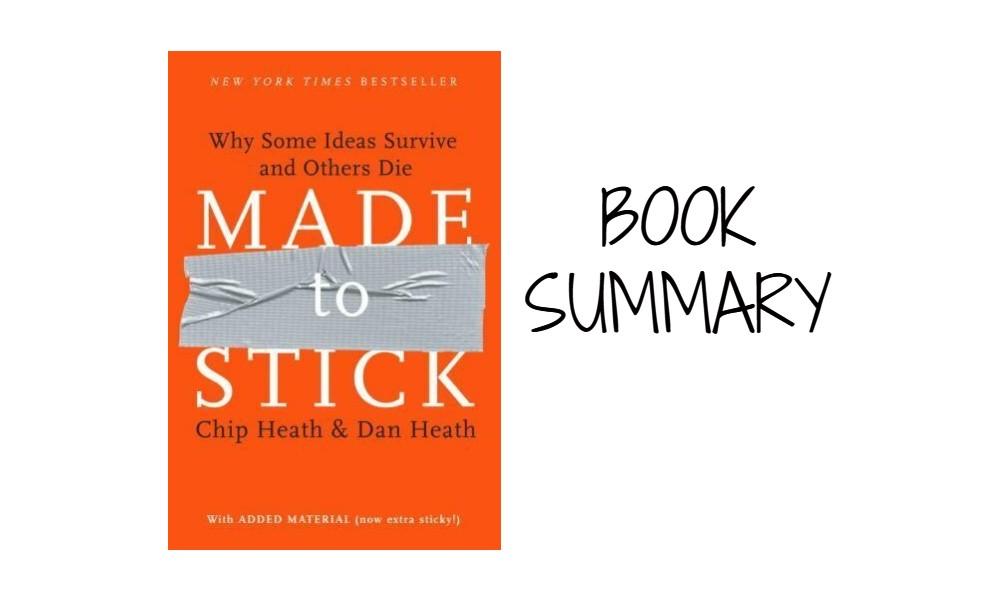
Have you ever had an idea/message that you were so convinced was going to be a hit, only for it to fall flat? Well, don't feel bad. We've all been there. But what if I told you that there's a science behind why some ideas stick and others don't? The answer lies in the principles of making ideas stick, and that's exactly what we're going to talk about today.
"Made to Stick: Why Some Ideas Survive and Others Die" by Chip Heath and Dan Heath teaches us how to make ideas memorable and effective in communicating a message. The book provides insights into what makes an idea or story stick in people's minds, and how to craft ideas that are easy to understand, remember, and act upon.
The book is divided into six sections that cover the following topics:
Simple: The book explains how to simplify complex ideas and make them easy to understand.
Unexpected: The book explains how to make ideas surprising and capture people's attention.
Concrete: The book explains how to make ideas concrete and easy to remember.
Credible: The book explains how to make ideas credible and believable.
Emotional: The book explains how to make ideas emotional and appealing to people's values.
Story: The book explains how to use stories to make ideas stick.
Let's try to understand these principles.
"Simplicity is not the goal. It is the by-product of a good idea and modest expectations."
Examples: The "CARE" package is a simple yet powerful idea that enables people to donate money to international aid organizations. Another example is the "Golden Circle" framework that Simon Sinek introduced in his book "Start with Why", which helps to simplify the message to explain why an organization exists, how it does what it does, and what it does.
How can we apply this in our life:
"People don't pay attention to boring things."
Example: The "Ice Bucket Challenge" campaign was unexpected and captured people's attention, raising awareness and funds for ALS research. Another example is the "Old Spice" campaign which was unexpected and created a lot of buzz and engagement.
How can we apply this in our life:
"People understand and remember concrete information better than abstract information."
Example: The "5-second rule" for dropped food is a concrete idea that helps people remember when food is safe to eat. Another example is the "McDonald's" golden arches, which are a concrete and recognizable symbol of the brand.
How can we apply this in our life:
"Credibility is the foundation of all persuasive communication."
Example: The "This is your brain on drugs" campaign used a credible and convincing egg-in-a-pan analogy to discourage drug use. Another example is the "Fedex" campaign that used real-life examples of their delivery services to make the brand more credible.
How can we apply this in our life:
"Emotions are the invisible force that shapes our decisions."
Example: The "Keep America Beautiful" campaign used emotional appeals to motivate people to take action against litter and pollution. Another example is the "Nike" "Just Do It" campaign that used emotional appeals to create a sense of determination and motivation.
How can we apply this in our life:
"Stories are a way to make our ideas stick in people's minds."
Example: The book explains how to use stories to make ideas stick. By using a story, an idea becomes more meaningful and memorable. The authors argue that stories are a way to make ideas stick in people's minds.
How can we apply this in our life:
These six sections provide important insights and practical advice for making ideas stick and be memorable for the audience. By understanding and applying these principles, you can create ideas that are more likely to be remembered, shared, and acted upon. It's important to note that one principle is not better than the other, they all work together to make an idea stick.
Let's say you were working on an ad for Social Media or TV.
How can you use these principles to improve the quality of your message?
Here are some questions you can ask yourself to help you apply these principles:

My goal is simple, protect what is important to you. I focus my energy on discovering your exposure to risk and building a comprehensive plan to protect you against those risk.